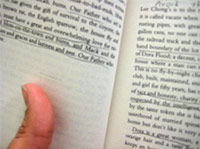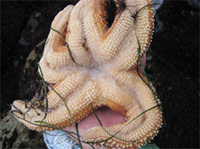
Teacher ResourcesReading Texts as Tide Pools: Understanding the Interrelation between Mankind and the World A Series of Lessons
|
||||
 |
 |
“Everything impinges on everything else.” — John Steinbeck |
|
Details
- Title of text(s): Log from the Sea of Cortez, The Long Valley, Cannery Row
- Grade: 11
- Lesson title: Reading Texts as Tide pools
Overview
As Steinbeck became accustomed to studying tide pools with his good friend and marine biologist Ed Ricketts, he began to write his characters and their surrounding environments as Rickets might have studied an organism and its surrounding organisms and marine environment in a tide pool. This series of lessons will teach students how to study and learn from a tide pool and then apply this same methodology to Steinbeck’s writing. It can then be applied to any other author’s works as seems appropriate.
Procedures
Note: As this is a series of lessons, lesson sequence or timing may need to be adjusted based on the length of class periods.
Session 1: Learning to Read Tide Pools
- What is a tide pool?
- Ask students if anyone has visited a tide pool? Have student(s) describe.
- Tide pools are pools of water left behind when the sea water recedes at low tide. They are home to dozens of different animals and plants living together. (Source: Monterey Bay Aquarium)
- Provide students with a list of tide pool species from which they can choose one for focus
- Learning to study or “read” a tide pool to understand species more fully
- Walk through the following steps with students before visiting/viewing tide pools.
- STEP 1: 20 minutes – Explore the Surface [SLIDE 3]
- Allow students to wander freely through the tide pools, taking in the space as a whole, stopping to look at whatever interests them.
- STEP 2: 5 minutes – Stop and Describe
- Students should find the tide pool species on which they chose to focus; they should spend five minutes quietly observing this species and describing what they notice and considering what questions they may have. It is VERY IMPORTANT that student get down at the level of the tide pool so that they do not miss out on the cool up-close details. Students should list at least 20 adjectives describing what they observe; notes can be recorded on 3x5 index cards.
- STEP 3: 5 minutes – Field Notes and Drawing
- The next five minutes should focus even more closely on the selected species in the given tide pool. Students are encouraged to ask a what or how question to focus their observation. For instance: how quickly does a hermit crab move? Or how big are sea stars when they are born? This time students will take more specific notes on one index card and draw what they observe or one part of it that interests them on another card.
- STEP 4: 5 minutes – Reflection
- This should be done as a whole-class after steps one through three are complete. Ask students to share adjectives, descriptions, drawings, and any other observations.
- Have students consider the process of tide pool exploration – what strategies can be applied to reading a text? Why is observing a tide pool species in its environment important (versus removing it for lab study)? How can this same concept be applied to human beings?
- If visiting a tide pool is not an option (nor any other accessible body of water), consider the following for video tide pools:
- Bay Nature tide pool overview video
- Also available at the above site or on YouTube: Crab and Anemone video, good for close-up study of one particular species
- Check out the Monterey Bay Aquarium Video Library for a series of short videos about marine life
Session 2: Non-Teleological Thinking – Applying the principles of tide pools to mankind
- Consider how the study of tide pool species can be connected to the study of homo sapiens. Steinbeck clearly saw the connection between the ways a marine biologist looks at tide pools and the way we might similarly examine human behavior to reach a heightened understanding of mankind.
- In chapter two of Log from the Sea of Cortez, Steinbeck articulates this connection (photocopy excerpt or project using PowerPoint).
- Steinbeck questions why the behavior of man is not examined with the same detachment of the biologist studying tide pools :
We have looked into the tide pools and seen the little animals feeding and reproducing and killing food. We name them and describe them, and, out of long watching, arrive at some conclusion about their habits […] but we do not objectively observe our own species as a species […] (15)
- Also consider Ed Rickett’s: “Inter-relation seems to be pretty much the keynote of modern holistic concepts, wherein the whole consists of the animal or the community in its environment, the notion of relation being significant.”
- STEINEBCK AND RICKETT’S APPROACH: This methodology of describing behaviors and environments as what “is” in a detached, scientific manner is known as NON-TELEOLOGICAL THINKING, as explained in the Easter Sunday section of Log:
Non-teleological thinking concerns itself primarily not with what should be, or could be, or might be, but rather with what actually “is” – attempting at most to answer the already sufficiently difficult questions of what or how, instead of why. (112)
- Returning to Chapter 2 (pages 15-16) from Log, Steinbeck applies this concept to the “murder trait” of homo sapiens (here Steinbeck compares human motivations for murder to crayfish in a rather humorous manner).
- Steinbeck questions why the behavior of man is not examined with the same detachment of the biologist studying tide pools :
Session 3: Texts as Tide Pools
- How can a text be compared to a tide pool?
- A marine biologist cannot truly understand a tide pool species by observing it as an individual organism; the surrounding environment and neighboring species play a significant role in shaping that individual organism.
- The same is true for mankind: the individual cannot be separated from the community nor the community from the environment (place matters): “Everything impinges on everything else.”
- Application to Steinbeck’s writing
- Consider these concepts in terms of one of Steinbeck’s short stories; consider:
- The Raid
- The Vigilante
- Johnny Bear
- Apply the tide pool approach when reading the story:
- STEP 1: Read the story once, exploring the surface.
- STEP 2: Consider one character of the text and stop and describe that character in a specific passage
- STEP 3: Dig deeper to better understand the character: how does he or she interact with other characters? What actions does he or she exhibit. How does he or she behave in different settings? Write a more detailed description of the character, using specific text references for support.
- STEP 4: Reflect on the even deeper meanings: what is Steinbeck saying about mankind – individual human behavior, community behavior, the environment, and the interrelation between all elements?
- Consider these concepts in terms of one of Steinbeck’s short stories; consider:
Session 4: The Tide Pool of Cannery Row
- Based on non-teleological thinking, just as “events are outgrowths and expressions [of everything around them] rather than results” (Log 112) in a tide pool, the people of Cannery Row and the community are enclaves out of the dominant culture.
- Based on these observations, studying Cannery Row and its people like he would a tide pool, Steinbeck crafted his novel Cannery Row.
- Read selections from the novel and apply the tide pool approach. Consider:
- Doc in his lab
- Lee in his market
- Mack and the Boys in the Palace Flop House
- Mack in the lab
- Mack in the market
- Dora and the Bear Flag
- Any other interesting observation of an individual character in various contexts to understand the character on a deeper level and, therefore, better understand Steinbeck’s notions of mankind
- During reading, provide students with a map of cannery row
- Read selections from the novel and apply the tide pool approach. Consider:
Extension – Session 5: In What Tide Pool(s) Do You Play a Role?
- Steinbeck grounded his writing in real-world people and events as evidenced in Real Life on Cannery Row. Cannery Row became Steinbeck’s own tide pool that he observed with the detachment of a marine biologist and the crafted into a stylized piece of “fiction” based on his observations.
- Brainstorm the tide pools of which you are a part: high school, family, study group, social circle, workplace, sports team, theater ensemble, musical group, etc. How do these environments influence and shape you? How must you adapt?
- Select one of the following final activities:
- Create a Google map that identifies the places that are significant in your world, as Steinbeck used personal “landmarks” on Cannery Row such as Ed Rickett’s Lab, Flora’s Café, and Wing Chong’s market (further instructions and tutorial available in attached PDF). Include photographs and/or video as well as detailed descriptions of the significance of each location.
- After observing and taking notes on your tide pool(s), write a short story. Remember that Steinbeck once said of Cannery Row, “The book is only fiction in form and style.” In other words, your short story should take on a creative form and style, yet be grounded in the realities of your world.
- Produce your own tide pool mural similar to the mural that reveals the relationships between Steinbeck’s life and works; accompany this with a narrative that explains the significance of the mural. You may do this digitally if you prefer. [SLIDE 14]
Word to the wise
Lessons would work best culminating in a reading of Cannery Row in its entirety, but if this cannot be done, selections from the novel will work. Consider pairing selections with non-fiction writing on the real people of Cannery Row (i.e., Doc and Ed Ricketts).
Sources
- Bay Nature. “Bay Nature Videos.” Bay Nature. Bay Nature Institute, 2008. Web. 5 Aug. 2009.
- Fink, Chris. “Steinbeck’s ‘Is’ Thinking: A Thing That Happened.” NEH 2009 Steinbeck Institute. Monterey, CA. 13 July 2009. Lecture.
- Google. “My Maps - Maps Help.” Google Maps. Google, 2009. Web. 6 Aug. 2009. <http://maps.google.com/support/bin/answer.py?answer=68480>.
- Lundy, A.L. ‘Scrap’. Real Life on Cannery Row: Real People, Places, and Events that Inspired John Steinbeck. Santa Monica: Angel City Press, 2008. Print.
- Monterey Bay Aquarium. “Video Library.” Monterey Bay Aquarium. Monterey Bay Aquarium Foundation, 2009. Web. 6 Aug. 2009. <http://www.montereybayaquarium.org/>.
- Steinbeck, John. Cannery Row. New York: Penguin Group, 1945. Print.
- - - -. The Log from the Sea of Cortez. New York: Penguin Group, 1941. Print.
- - - -. The Long Valley. New York: Penguin Group, 1938. Print.
- Strang, Craig. “Introduction to the Intertidal.” NEH 2009 Steinbeck Institute. Monterey, CA. 20 July 2009. Lecture.


